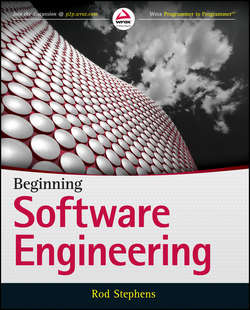Читать книгу Beginning Software Engineering - Stephens Rod - Страница 1
INTRODUCTION
ОглавлениеProgramming today is a race between software engineers striving to build bigger and better idiot-proof programs, and the universe trying to build bigger and better idiots. So far the universe is winning.
– RICK COOK
With modern development tools, it's easy to sit down at the keyboard and bang out a working program with no previous design or planning, and that's fine under some circumstances. My VB Helper (www.vb-helper.com) and C# Helper (www.csharphelper.com) websites contain thousands of example programs written in Visual Basic and C#, respectively, and built using exactly that approach. I had an idea (or someone asked me a question) and I pounded out a quick example.
Those types of programs are fine if you're the only one using them and then for only a short while. They're also okay if, as on my websites, they're intended only to demonstrate a programming technique and they never leave the confines of the programming laboratory.
If this kind of slap-dash program escapes into the wild, however, the result can be disastrous. At best, nonprogrammers who use these programs quickly become confused. At worst, they can wreak havoc on their computers and even on those of their friends and coworkers.
Even experienced developers sometimes run afoul of these half-baked programs. I know someone (I won't give names, but I also won't say it wasn't me) who wrote a simple recursive script to delete the files in a directory hierarchy. Unfortunately, the script recursively climbed its way to the top of the directory tree and then started cheerfully deleting every file in the system. The script ran for only about five seconds before it was stopped, but it had already trashed enough files that the operating system had to be reinstalled from scratch. (Actually, some developers believe reinstalling the operating system every year or so is character-building. If you agree, perhaps this approach isn't so bad.)
I know another experienced developer who, while experimenting with Windows system settings, managed to set every system color to black. The result was a black cursor over a black desktop, displaying black windows with black borders, menus, and text. This person (who wasn't me this time) eventually managed to fix things by rebooting and using another computer that wasn't color-impaired to walk through the process of fixing the settings using only keyboard accelerators. It was a triumph of cleverness, but I suspect she would have rather skipped the whole episode and had her two wasted days back.
For programs that are more than a few dozen lines long, or that will be given to unsuspecting end users, this kind of free-spirited development approach simply won't do. To produce applications that are effective, safe, and reliable, you can't just sit down and start typing. You need a plan. You need … <drumroll> … software engineering.
This book describes software engineering. It explains what software engineering is and how it helps produce applications that are effective, flexible, and robust enough for use in real-world situations.
This book won't make you an expert systems analyst, software architect, project manager, or programmer, but it explains what those people do and why they are necessary for producing high-quality software. It also gives you the tools you need to start. You won't rush out and lead a 1,000-person effort to build a new air traffic control system for the FAA, but it can help you work effectively in small-scale and large-scale development projects. (It can also help you understand what a prospective future boss means when he says, “Yeah, we mostly use Scrum with a few extra XP techniques thrown in.”)
